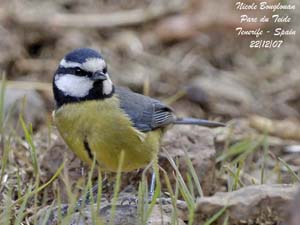
African Blue Tit – Cyanistes teneriffae
Passeriforme Order - Paridae Family
QUELQUES MESURES :
Length : 11-12 cm ; Weight: 10 g
DESCRIPTION:
African Blue Tit resembles our pretty Blue Tit (Cyanistes caeruleus), but some details in plumage and colours make it different. The African Blue Tit is a high-intensity version of the Common Blue Tit.
Adult has grey-blue upperparts. On the wings, coverts and alula are greyish with blue edges. The flight feathers are dark grey, edged with bright blue, whereas the tertials are slightly tipped white. African Blue Tit differs from Common Blue Tit by lacking white wing bar.
The uppertail is dark grey-blue, with bright blue fringes. Outer rectrices are slightly edged white.

On the underparts, breast, belly and vent are deep yellow with blackish central line, becoming paler on belly. Undertail coverts are green-yellow, as underwing coverts.
On the head, the crown is deep blue, becoming darker on the hind crown. The blue crown is surrounded by broad white line, including forehead, supercilium and hind crown. Cheeks are white too, separated from the previous white line by blackish eye line which starts from the lores, through the eyes and ends on the nape.
The sharp, powerful bill is blackish. Eyes are dark brown to blackish. Legs and feet are blue-grey.
Both sexes are similar. Juvenile resembles adults, but it has yellow forehead, supercilium and centre of nape. Its plumage is duller, and it lacks the black line in the breast.
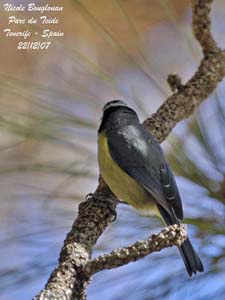
African Blue Tit (at this moment Cyanistes teneriffae), has four subspecies which live in other Canary Islands. They slightly differ in colour of plumage and pattern.
Cyanistes teneriffae teneriffae lives on Tenerife, Gran Canaria and La Gomera.
Cyanistes teneriffae palmensis lives on La Palma.
Cyanistes teneriffae ombriosus lives on El Hierro.
Cyanistes teneriffae degener lives on Lanzarote and Fuerteventura.
VOICE: SOUNDS BY XENO-CANTO
African Blue Tit’s alarm call is a loud « cher-er-er-er-er-g », sometimes with short « chi » or « chi-chi-chivichi” uttered just before the alarm call.
The song is a series of notes “chichi-chirichi-chirichi” powerful and melodious. We can hear some variations more or less melodious, but fairly musical.
Each subspecies utters variations of these sounds.
HABITAT:
African Blue Tit breeds in varied wooded habitats such as laurel woodlands, barrancos (wooded gulleys), Euphorbia scrub, urban parks and gardens. It is also found in pine forest (Pinus canariensis), up to 1800-2000 metres of elevation on Tenerife.
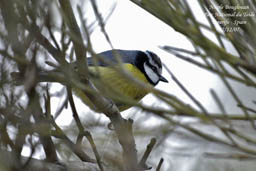
RANGE:
African Blue Tit is endemic to Canary Islands and resident in its range.
BEHAVIOUR:
African Blue Tit, as Common Blue Tit, is often seen in pairs or alone, and sometimes in small family groups. It feeds on insects and seeds, and probably fruits.
This bird is fairly tame and often approaches in order to take food from humans.
It forages as in undergrowth or at varied levels in trees, such as pines or palm trees, and other vegetation.
Very agile, this bird is able to feed upside down, mainly on thin branches or pine cones. It also may pursue insects in flight.
It performs “hammering”, holding the food between the feet on a branch or other hard surface, and striking several times with the bill, in order to crack open seeds or nuts, or to kill some caterpillar or insect.
During breeding season, male performs courtship feeding, regularly offering food to female. Female begs food as young birds, slightly crouched with shivering wings. She may receive a third of her food from the male.
African Blue Tit is resident in its range, but it may perform some altitudinal movements for food.
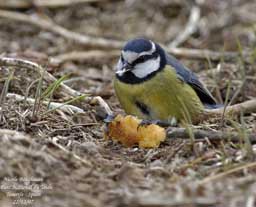
FLIGHT:
African Blue Tit has buoyant flight and performs mainly short distance flights from tree to tree. On longer-distance flights, it has more undulating flight.
REPRODUCTION:
Breeding season occurs mainly between February and July, but also between October and January. It depends on the elevation, and the bird breeds earlier at lower level than in higher areas.
African Blue Tit’s nest is often situated in cavity, such as hole in tree or crevice in trunk, wall or rock, artificial nest-box, and even on the ground.
The structure is similar to that of Common Blue Tit, but materials are different according to the availability within the habitat.
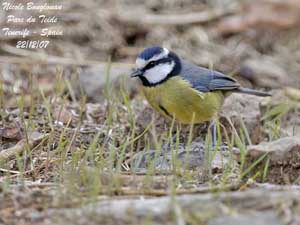
African Blue Tit usually uses grass or dry plant material, instead of moss which is scarce in such habitat. It also uses hair and feathers, pine needles and leaves. The nest is usually at about 3 metres above the ground.
Female lays 3 to 6 eggs.
The nesting behaviour of this species is unknown, but it is probably similar to that of Common Blue Tit.
DIET: African Blue Tit feeds mainly on insects such as small butterflies and small beetles. It also consumes seeds, nuts and some fruits.
PROTECTION / THREATS/STATUS:
African Blue Tit is common in its range on Tenerife and Gran Canaria. It is scarcer on Fuerteventura and Lanzarote where the race “degener” suffers poor breeding success and is threatened by the increasing desertification of both.
Fr: Mésange de Tenerife
All : Blaumeise-teneriffae
Esp : Herrerillo Africano
Ital : Cinciarella di Tenerife
Sd : Koboltmes
Text and photographs by Nicole Bouglouan
Sources:
HANDBOOK OF THE BIRDS OF THE WORLD Vol 12 by Josep del Hoyo-Andrew Elliott-David Christie - Lynx Edicions - ISBN: 8496553423